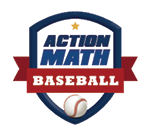
Action Math Baseball
Key Math Standards
Aligned to Action Math Baseball Activities

Activities in Action Math Baseball are linked to key math standards. As students interact with the simulation, the software automatically tracks and measures their performance and generates class and student assessment reports.
| Standard Description | Game Activities |
|---|---|
| 1. Evaluate numerical expressions using parentheses, brackets, or braces. |
|
| 2. Compare decimals up to thousandths. |
|
| 3. Use place value to round decimals to any place. |
|
| 4. Add, subtract, multiply, and divide decimals using concrete models. |
|
| 5. Solve problems involving addition and subtraction of fractions. |
|
| 6. Understand ratio concepts and use ratio reasoning to solve problems. |
|
| 7. Understand the concept and derive a unit rate associated with ratio. |
|
| 8. Use ratio and rate reasoning to solve real-world and mathematical problems. |
|
| 9. Fluently multiply multi-digit numbers using a standard algorithm. |
|
| 10. Fluently add, subtract, multiply, and divide multi-digit decimals using a standard algorithm for each operation. |
|
| 11. Write and evaluate numerical expressions in which letters stand for numbers. |
|
| 12. Understand solving an equation or inequality as a process of answering a question: which values from a specified set. |
|
| 13. Use variables to represent numbers and write expressions when solving a real-world or mathematical problem. |
|
| 14. Recognize a statistical question as one that anticipates variability in the data related to the question and accounts for it in the answers. |
|
| 15. Summarize numerical data sets in relation to their context, such as Reporting the number of observations. |
|
| 16. Recognize and represent proportional relationships between quantities. |
|
| 17. Use proportional relationships to solve multistep ratio and percent problems. |
|
| 18. Represent addition and subtraction on a horizontal or vertical number line diagram. |
|
| 19. Apply and extend understandings of multiplication, division and of fractions to multiply and divide rational numbers. |
|
| 20. Solve multi-step real-life mathematical problems posed with positive rational numbers (whole numbers, fractions, and decimals), using tools strategically. |
|
| 21. Display numerical data in plots on a number line, including dot plots, histograms, and box plots. |
|
| 22. Approximate the probability of a chance event by collecting data that predicts the approximate relative frequency given the probability. |
|
| 23. Develop a probability model and use it to find probabilities of events. |
|
| 24. Find probabilities of compound events using organized lists, tables, tree diagrams, and simulation. |
|
| 25. Make sense of problems and persevere in solving them. |
|
| 26. Reason abstractly and quantitatively. |
|
| 27. Construct viable arguments and critique the reasoning of others. |
|
| 28. Model with mathematics. |
|
| 29. Use appropriate tools strategically. |
|
| 30. Attend to precision. |
|
